Meet Sisters Elena & Margherita Micheluzzi, the Next Generation of Venetian Glassmakers
Issue #69
The tradition of glassmaking on the island of Murano dates back more than 700 years, so it’s no wonder that Murano glass is famous around the world. But with the industrialization of glass production, Murano’s artisans are struggling to keep this traditional craft alive. That’s why it’s so exciting to see the work of Elena and Margherita Micheluzzi, sisters who decided to follow in their father’s footsteps and teamed up to create Micheluzzi Glass, a studio that creates beautiful glass objects that bridge the gap between art and design.
On my most recent trip to Venice, I saw some of their vases at the Violino d’Oro, a new member of the Leading Hotels of the World that opened last November, and then was introduced to them by the hotel’s young owner, Sara Maestrelli. Sara took me to visit their gallery in Dorsoduro and they gave us a behind-the-scenes peek at their studio, where they work with artisans to cold carve the vases created for them by a furnace in Murano. Their delicate drinking glasses and heavy, textured vases are unlike anything else you’ll see in Venice. This interview with them was conducted in conjunction with a profile of them I wrote for Nuvo. I’m thrilled to share it as part of my series of interviews with creatives and entrepreneurs in Italy.
Can you introduce yourselves?
Elena: Our story with glass starts with the fact that our father is a glass artist who works with glass for 30 years. He has been involved in the world of glass for a long time, but he began to make his own things when we were 10 or 15 years old. So we remember when he started to make glass. It’s something we have lived since we were young, but old enough to remember it.
But we always thought that he was the artist, so we never imagined working in this world because it was his world, even if we were acquainted with it. We have our house upstairs and it’s always been a family business, with our mother working here. We followed our paths—me in contemporary art and my sister in fashion. We both left Venice when we were 18 or 19 years old, living in Milan and London. I also had a period of time in Paris. Then for six or eight years we both lived in London and a bunch of factors conspired to give us the idea to work with our father in the world of glass.
Margherita: I would just add that in all these years, it wasn’t in the cards for us to return to Venice and work with our father. In part because it was very important for our parents that we leave Venice and study abroad, it was very difficult to unite these two things because we were pushed to get experience elsewhere. So we never even talked about the possibility of working with our father.
Then without having a plan really, we had a conversation about the idea of making glasses because our father has explored every type of technique—over the course of 30 years he has experimented a lot—but the thing he never concerned himself with was glasses. At the time, we were both living in London and I had shifted from fashion to interior design. And in that period, I worked for a brand that also worked with glasses made in Murano.
So I started to explore this thing because I had seen more vases than glasses, since our father never made them, so I began to ask, “Why haven’t you ever thought about making glasses?” And he responded, “Great idea! You can make them.” So that’s how it started. At the beginning, we thought about giving him some input and doing a project together, but we didn’t think about doing it all ourselves, since we were both working in London and didn’t intend to leave.
Elena: It all happened quite spontaneously. Of course, we had the possibility of going and trying because we had the help of our father, but it happened quite quickly that we went from nothing to all in.
Margherita: It helped that we had a furnace already where we could make things, but also a place to sell them. I remember that we made our first set of 12 steel gray glasses in January. This conversation we’ve been telling you about took place around Christmas 2018 in London and in January 2019, after vacation, we entered Murano.
So these glasses arrived in the shop around the end of January and I remember very well that around February 15, dad called me at the office in London and said, “I sold your set of 12 glasses.” And I started crying, “Someone bought our glasses!” We had made only that. So we immediately made them in other colors.
Elena: Because we had the advantage that we didn't have to find a place to sell them. Dad said, “If you want, I’ll give you a shelf where you can put your things and we’ll see how it goes.” In the beginning, we only made glasses, which was parallel to what our father was doing because as artisanal and artistic as they can be, they’re objects made for daily use, while for him it’s more about art for art’s sake. So we had the idea to make glasses, but he said immediately, “You can’t only make glasses. You have to make vases.”
Have the glasses always been those wavy ones?
Elena: Yes, our father told us, “Look, it’s not easy to make beautiful glasses because everything has already been done. You need a new idea.” And the only way to get an idea was to go to the furnace and look around. The furnace where we work is an artistic furnace that only works with artists, not a commercial one, but it has an archive where we could see what was done in the past. And then there are also shelves upon shelves of discards, broken things, things that didn’t come out right, and my sister saw these glasses that were discarded.
When a glass doesn’t come out right when it’s being made, it gets pinched because it has to be put together with the other glasses in another sort of oven that lowers the temperature gradually, because if you take hot glass out of the oven abruptly, it explodes. So to recognize glasses with defects like ugly bubbles or something, they pinch them so they’re distorted.
So that gave us the idea—along with our father, who makes things with organic forms—to use a similar movement. So we did some tests, sketches, and regular shapes that seem like waves. So there’s an unconscious reminder of water and waves. We realized after that all of our ideas come from that.
Margherita: It’s our father’s highest form of inspiration.
Elena: We inherited it and revisited it with different things. But in the end, this natural world that influences us inspired us since the beginning, without us even realizing it. So we found a way to shape these glasses in a gentle way.
Margherita: The artisans who work in the furnace tend to be a bit skeptical of new things. Our furnace master is someone who works with the best artists, but in the beginning he looked at us a bit strangely. Now, though, it’s been years that he makes them everyday.
Elena: And then we started to make them in many different colors, we started to add the lines, which are characteristic of glasses from Murano. Having this edge gives a classic touch to something modern. Then we made many variations.
So how did the vases come about?
Elena: Because our father said, “If you’re going to start working with glass, glasses are like toys. You have to make vases.” And he immediately suggested starting with small, simple things. He has made some very elaborate things, but his approach is to follow the material rather than an idea, without stressing the material to make it fit a conceptual idea. So he told us to start with simple forms and small things. And in order to give them our touch, we thought about the various applications and techniques one can use to make these objects unique.
Margherita: Cold carving is a technique our father used in the past, especially for smaller projects. Then over time, he hadn’t abandoned the technique, but he was using it much less. So we did some archival work, which was really fun because we were little when our father concentrated on smaller objects.
Elena: And we revisited this style in a new way. Certainly much more colorful because we wanted to give more variety to our collection. So we realized that we could start to make objects that were a bit bigger. So from one form, you get four or five by elongating, then with different colors and different patterns, we were able to create a variety of objects but also keep the continuity because you can see an evolution of the style.
Margherita: We think of it as a collection to collect. Over time, many of our clients buy a piece, then they buy another, and they can create a little group or put them in different places in their house. They’re different colors, different carvings, different shapes, but they go together. And then something else I want to add is that creating this collection, we realized how our desire was to make them functional.
Elena: Because we want to be in continuity with our father but complimentary.
Margherita: And we realized that over the years, our father made many experiments, many gifts. We grew up around glass, our mother used glass objects to decorate the table, we always had glass receptacles on side tables, so the idea for this collection is to be decorative but also functional.
Elena: We make objects that can contain small things or be used. Some ideas are ours and some come from clients who say, “A candle would be beautiful inside.” All of our peers are used to having glass around because we’re in Venice. But for many people, it’s considered an object more from the past than the present. It’s very delicate. But the way that we present it is much more modern. Our glass has to be thicker, so it gives you the impression that it's not too fragile. You can use it.
Why is it important to keep the tradition of glassmaking alive?
Elena: Because it’s an immense treasure. Going to the furnace and seeing what they do and what’s possible, they have incredible capacities that date back hundreds of years. We entered this world recently, and it had its problems before us, but now we have arrived at a point where for questions of cost or know-how, there’s a crisis. Half of the furnaces in Murano have closed or are empty. There are always less people. The master artisans are getting older.
In the past, there were enormous furnaces with a lot of staff because glass was used differently. It had a different cost and there wasn't the element of design. Now we have design objects or go buy things from Ikea. So that type of artisanship has become art. There’s a different approach.
Now the places that work in Murano are touristy furnaces that sell things to people who are looking for things recognizable as from Murano or else the art world, which has nothing to do with Murano or Venice, but rather the whole world. So the dynamics have changed because they’ve had to adapt. Venice has also changed in the last ten or twenty years.
We’re not from Murano, we’re not the daughters of a master glassmaker, we can’t blow glass ourselves, but we’ve discovered this world in a different way. What we can do—and there is a little community of young people trying to do it—is to continue to support this world because if we work, they work.
Further Reading
Check out my aforementioned profile of Elena and Margherita for Nuvo here.
As I mentioned in the intro, you can see examples of their work at Violino d’Oro. To learn more about the hotel and its enviable art and design collection, read my ‘First In’ review of the hotel for Condé Nast Traveler.
Elena and Margherita were also featured in this article by the BBC about Venice’s ‘unbreakable’ women of glass, which I enjoyed reading when I was preparing to interview them.
I also included their glass objects in last year’s holiday gift guide for Italophiles.
You can see all the interviews in this series here.






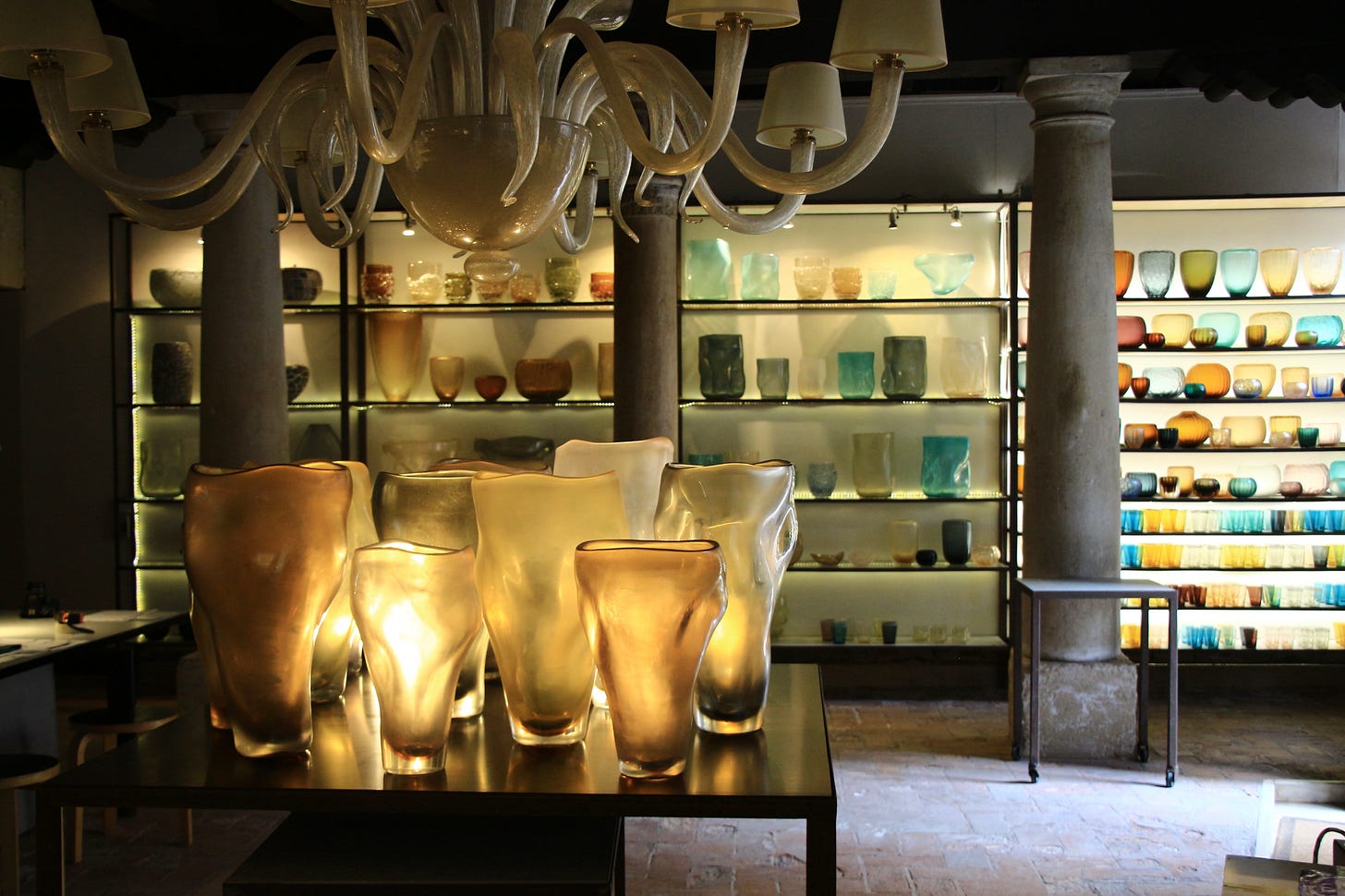
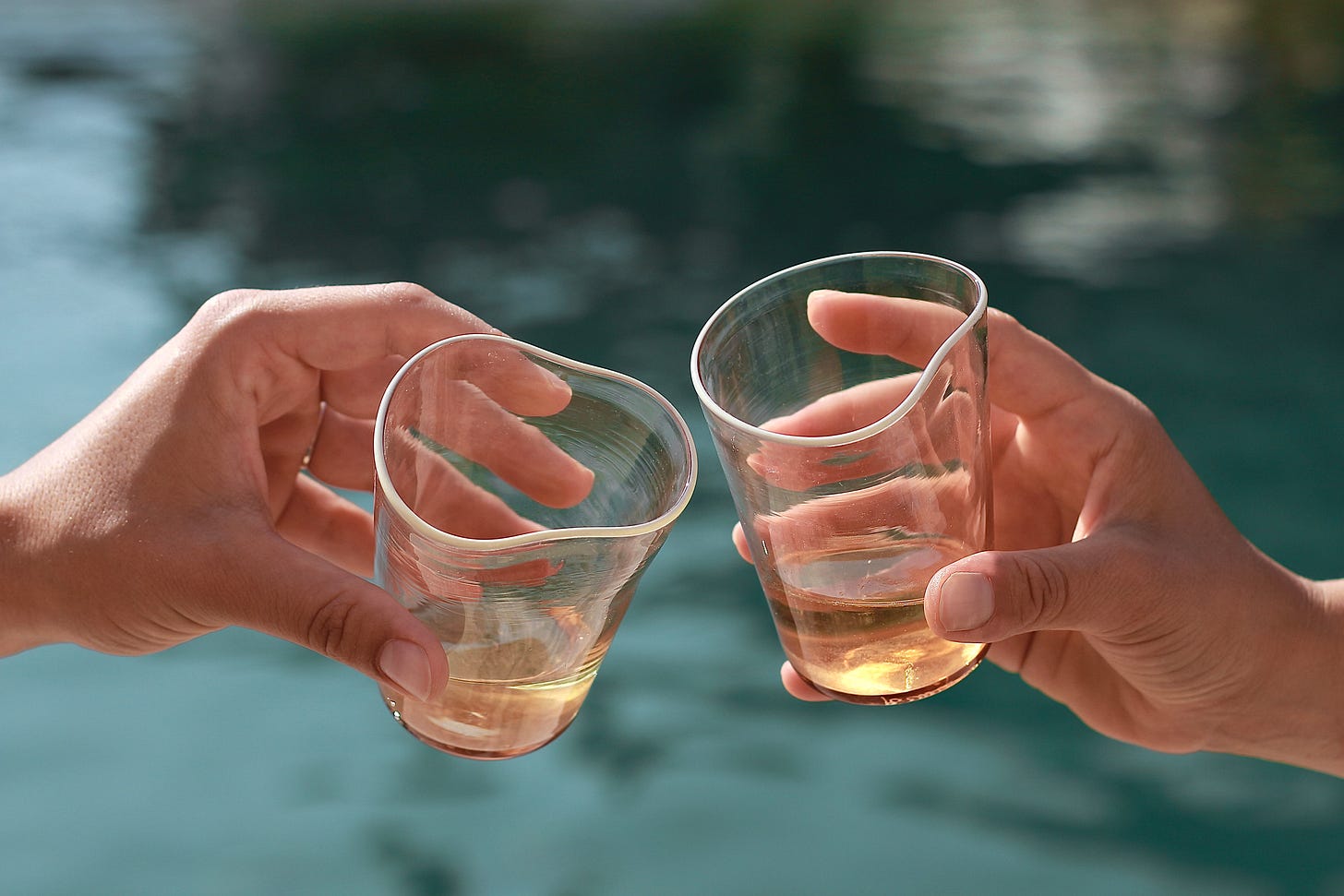
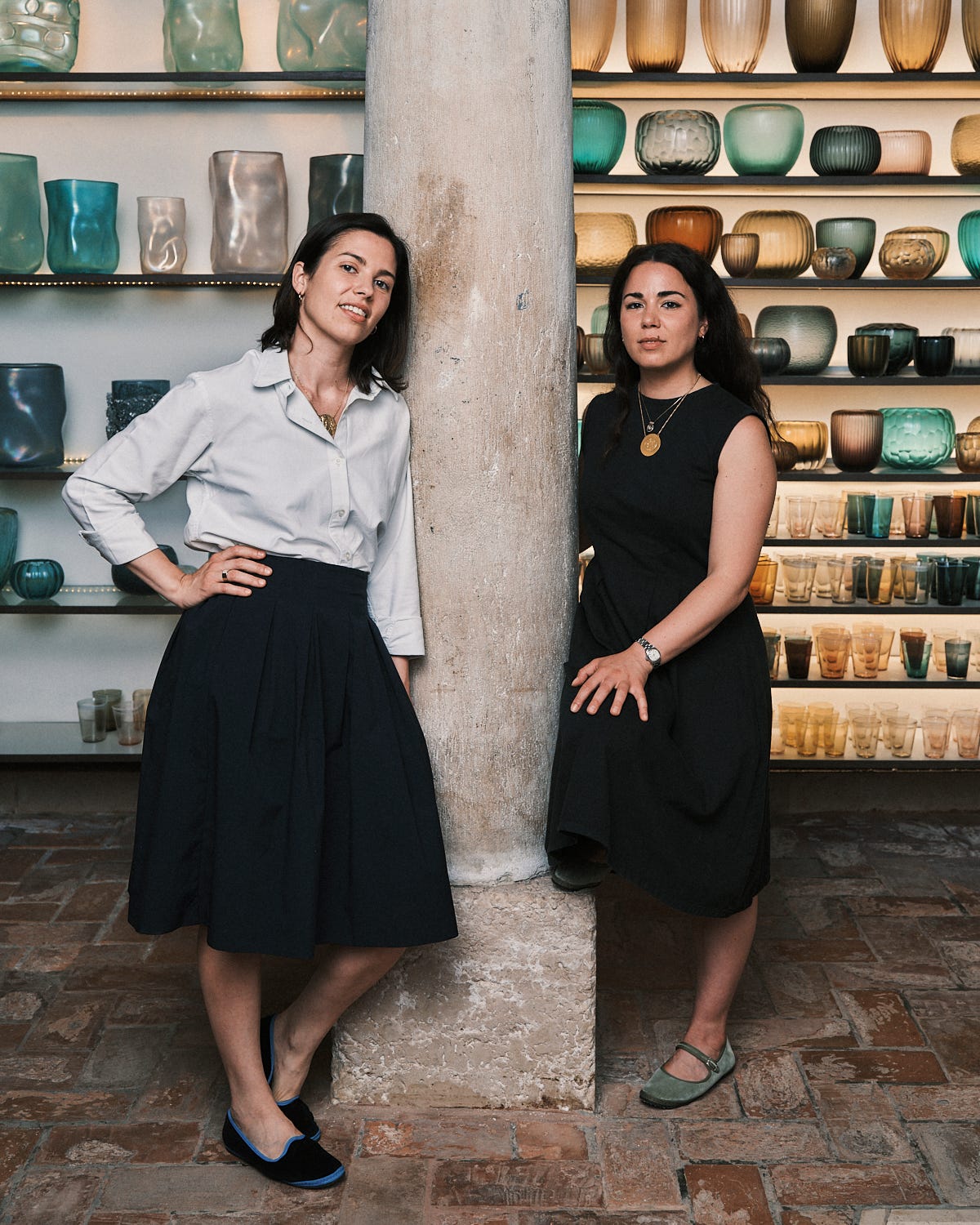
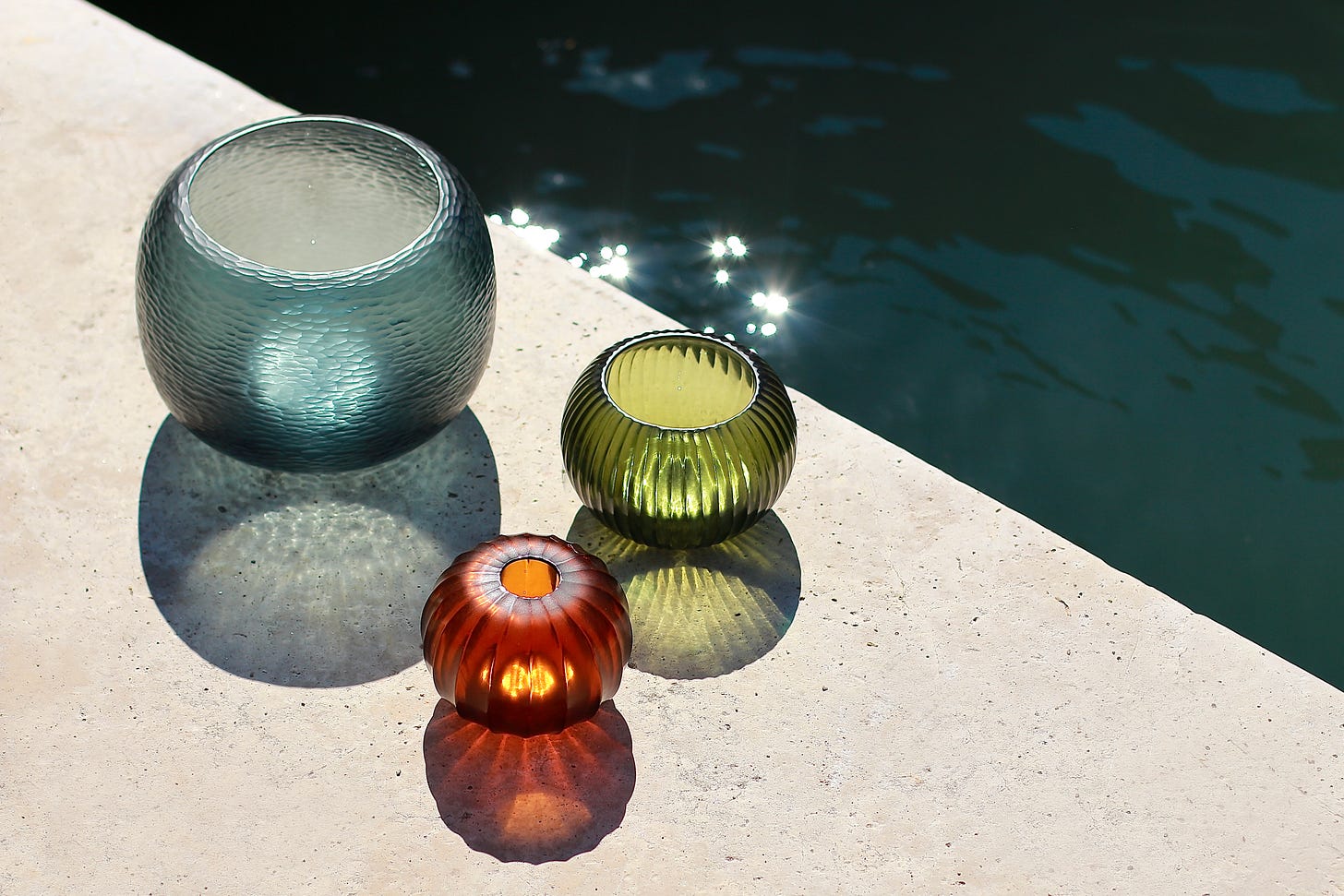
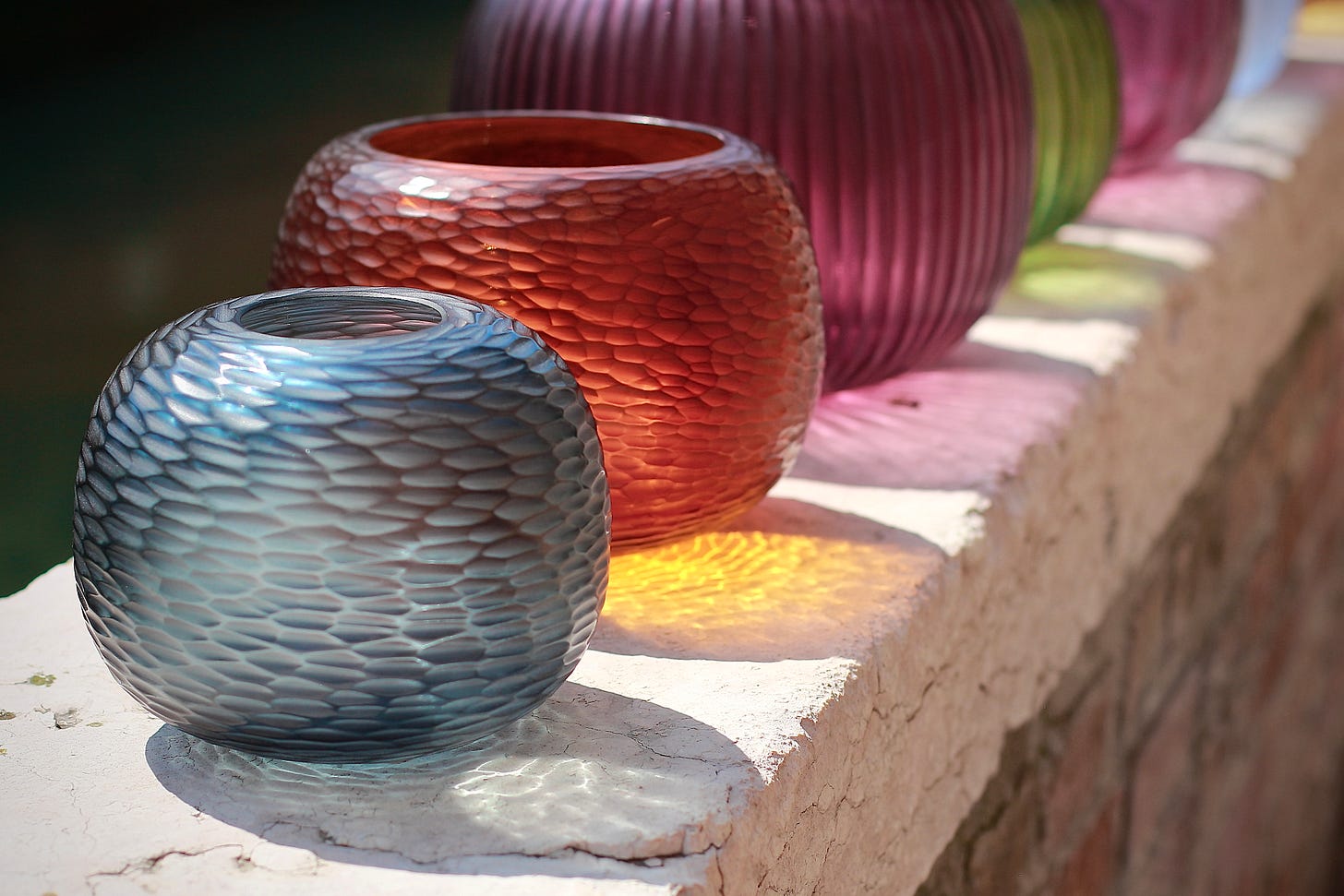
This article was wonderful. I am a stained glass crafter and love seeing glass artisans creations.
Thank you for sharing their passion and website info!!
Great story--- and the work is incredible. Maybe it's just my experience, but Elena and Margherita's progression-- leaving to pursue professional opportunities in Milan, London, etc. but then at a certain point returning to the family's artigiano business-- seems much more common in Italy than in a lot of other countries, the US included. It's a beautiful thing really, because they bring not only new energy but a fresh aesthetic perspective as well.